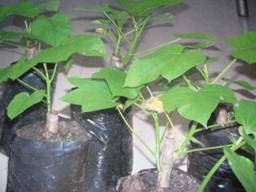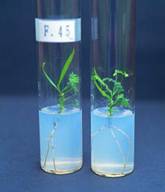
|
|||||||||||||
| Home | About Forestry | Eco-Tourism | Forestry Addresses | FAQs | Contact Us | |
|||||||||||||
| Clonal Forestry | |||||||||||||
CLONAL PROPAGATION IN TREES AN OVERVIEW
|
|||||||||||||
| INTRODUCTION |
| UTILITY OF CLONAL PROPAGATION IN TREES |
| LIMITATIONS OF CLONAL PROPAGATION |
| OPERATIONAL USE OF CLONAL PROPAGATION |
Clonal selection and deployment is receiving attention as an intensive forest management tool for increased wood production. Many pulp, paper and other wood based industries are now establishing clonal forestry programme after the promulgation of 1988 National Forest Policy. The new policy under para 4.9 has given clear indication that the forest based industries must prefer to raise required raw materials by themselves. The industries should establish direct relationship with individual growers of raw material by providing them credit, technical advice, harvesting and transport services. The policy also indicated that small and marginal farmers have to be encouraged to grow wood species required in forest based industries in their marginal and submarginal lands. This has created excellent scope for establishing plantations of industrial importance using clonal propagation. Many wood based industries in particular, pulp and paper industries are involved in plantation establishment programme using clonal forestry approaches in the recent past. However, there is no systematic approach for clonal forestry establishment and also there is growing interest to develop in future industrial wood plantations through clonal forestry approaches. The need to all stakeholders is a readymade reference material incorporating the strategies, methods, and experiences of stakeholders in the area of clonal forestry.
a) Production of quality planting stock
In the intensive management of forests it is very important of develop fast and economical methods of raising superior planting stock. The somatic propagation of trees has an edge over raising of stock through seeds. These techniques have also become important in forestry owing to their potential in propagating trees, which possess superior traits, in an effort to increase volume and quality of production.
There are many tree species, which normally produce little or no viable seeds, and some tree seeds have poor germination capacity. Such trees can easily be propagated vegetatively. Propagation by vegetative means is easy, more rapid and economical than by seed. In some tree species, germination is very poor or slow or there may exist complex dormancy problems or the seed may lose its viability very quickly. Moreover, seedlings of many species grow slowly and take a long time to reach marketable size. In all these cases, use of vegetative multiplication is a more convenient method of propagation.

Most of the tree species are cross-pollinated and naturally they are highly heterozygous. The progenies of such cross-pollinated trees are not true to type and loose many of their unique characteristics. Hence, asexual clonal propagation helps in maintaining the genetic characteristics of each species.
Certain tree species are often susceptible to some pests and diseases and others may be partially or entirely resistant. Vegetative approaches using grafting will help to produce resistant clones.
Vegetatively propagated plants are precocious in bearing i.e. Flower earlier than seed propagated plants. This will help to reduce the rotation of the tree species and also to increase the productivity. This will ultimately help to speed up the reproductive cycle for accelerated breeding and testing.
Vegetative propagation helps to preserve the genotypes in clonal banks. This will also help to evaluate genotypes and their interaction with the environment through clonal testing. This method of propagation will help to conserve and multiply the valuable trees in a centralized area such as in a laboratory or green house for intensive study and breeding.
Vegetative propagation ultimately helps to capture maximum genetic gains when used for regeneration in operational planting programme.
Clonal propagation in many forestry tree species is more expensive than seed propagation. It is a specialist’s job and requires special training and knowledge on the part of the propagator.
Vegetatively propagated plants are comparatively short lived. Lack of tap root system in vegetatively propagated trees results in poor anchorage in the soil; consequently such trees are easily uprooted during heavy winds or storms.
The clonal multiplication reproduces clones, which contain all the genetic information of the parent tree. The term clone is used to mean a genetically uniform plant material derived from a single individual and propagated exclusively by vegetative means. Before going for clonal propagation, the first step is selection of genetically superior tree or elite tree or mother tree. The selection guidelines for various tree species are discussed in chapter II. After selecting the trees, the clonal materials are collected and used for propagation. The cultural requirements of all the individual members of a clone are under a particular site of environment conditions. Environment can modify the growth and development of individual members of a clone. Clones are less broadly adopted. Eventhough each members of a clone has the same genotypes, the individual genotypes can possess a considerable ability for adoption to differing adverse environments. It is possible to select clones that posses greater adoptability than that possessed by the seedling. A forest tree needs great adaptability mainly to survive and to reproduce.
REFERENCE: Surendran, C., Parthiban, K.T., Vanangamudi, K., and Balaji, S., 2000. Vegetative Propagation of Trees, Principles and Practices.1-154, TNAU press, Coimbatore-03.
© All Rights Reserved. TNAU-2014.
